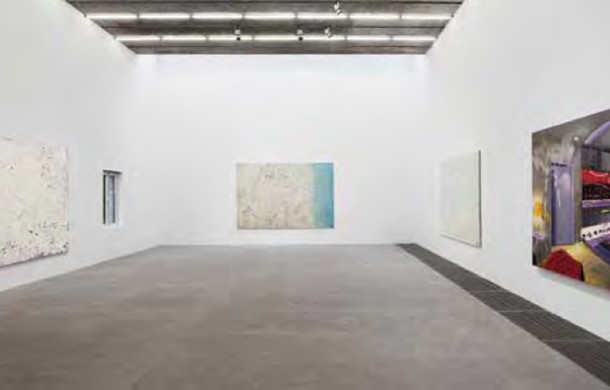XIE NANXING: THE SECOND ROUND WITH A WHIP
| May 10, 2013 | Post In LEAP 19

“The Second Round With a Whip” exhibits two new series of large-scale oil paintings by Xie Nanxing, at first glance a strange combination of interior design mock-ups and mottled abstraction sloppily thrown together without much consideration, even with a slight hint of uncoordinated humor. Continuing on from his last solo exhibition in the same space “Stepfather Has an Idea!” (2010), and drawing on the even earlier “Big Show: Xie Nanxing” (2008), Xie has driven forward his experimental painting. From “The First Round With a Whip” to this, “The Second Round With a Whip,” you are already looking forward to the next round with a whip, to see what else can be whipped up in this style. But using varied and unique painterly languages to create puzzling images on the canvas, and to, through this method, push the very boundaries of conceptual painting… is there still room to dig deeper?
As usual, the pieces in the exhibition did not make clear reference to any familiar narrative. Even basic clues are deliberately dusty, requiring the viewer to linger for an extended period before the deep meaning within slowly unfolds. Otherwise, each piece would appear independent of the outside, with no link to the incomprehensible and deliberately mystifying story the artist is attempting to tell. This deliberate action, of constructing a barrier to the viewer, is embodied in the “Canvas Prints” series, in which Xie Nanxing has once again woven a layer of coarse canvas between the brush and canvas and smeared and painted on this separate canvas. The paint drips through spot by spot onto the work below, forming a “new,” vague, and hard to distinguish “image.” Upon removing the separate layer, on the work below remain only traces of the story being told. The same method was used in his 2009 “Untitled” series, in which the color stains that the permeated fairy tales left behind provided us with a cryptic view of the original plot, the edge of the canvas screen on the frame revealing the artist’s method. If one can say that there is a clear relationship between an artist’s movement and a painting’s psychology, Xie’s “painting” clearly exposes some kind of hiding of his inner consciousness, or a tacit confrontation of the invasion of the current art system on individual practice; complexity of visual thought in these definite actions is decomposed and digested.
In the interior design renderings, Xie Nanxing has not refrained from actual form. The furnishings in the panting are all enveloped in a kind of cheap lighting. The direct source material of these paintings is an interior decorating reference book. In general, a rendering is a painting the designer will give the homeowner to demonstrate the intended effect. In this kind of painting, the artist will pay particular attention to an effective grasp of spatial perspective, ambiance and material texture; it is not a reproduction, but a virtual construction built on top of an existing “text.” If looked at logically, these types of paintings are the complete opposite of Xie’s “Canvas Prints” series. The artist draws from an experience outside that of historical painting, once again returning to the text’s expression of compositional relationship in painting. But for Xie this discussion is intrinsically linked to his earlier character-based paintings. As for private experiences concealed by types of titles such as “White Esses”— even if such simply refers to white lighting— perhaps we can consider these part of the artist’s intuition, unable to be shared. From that point of view, both types of work in this exhibition accomplish the same thing, just in different ways. (Translated by Duncan Darroch-Thompson)


